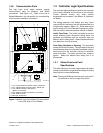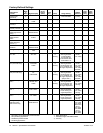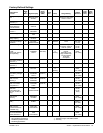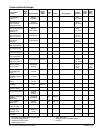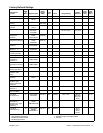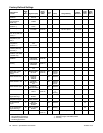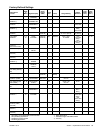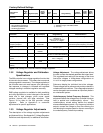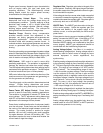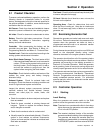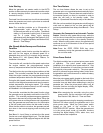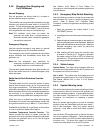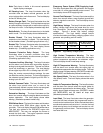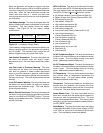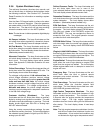TP-6200 10/12 31Section 1 Specifications and Features
Engine speed recovery depends upon characteristics
such as engine make, fuel type, load types, and
operating conditions. The underfrequency unload
setting should match the engine speed recovery
characteristics for the application.
Underfrequency Unload Slope. This setting
determines how much the voltage drops during an
underfrequency condition. Typically, applying a large
electrical load causes a dip in engine speed and
frequency. The voltage regulator reduces voltage,
allowing engine speed recovery. The volts-per-Hz
setting determines the amount of voltage drop.
Reactive Droop. Reactive droop compensation
provides reactive current flow adjustment in the
generator set during generator set-to-generator set
paralleling applications. Reactive droop reduces
excitation levels with increasing reactive current. A
reduced excitation level reduces generator set reactive
current or generated VARs, improving reactive load
sharing.
Enter the gain setting as a percentage of system voltage
when full-rated load with 0.8 power factor is applied. Any
loads less than full load force the voltage to drop by the
ratio of reactive volt-amps (VARs) to rated VARs.
VAR Control. VAR control is used in some utility
paralleling applications. The excitation is regulated to
maintain the reactive load rather than output voltage.
The VAR adjust setting determines what reactive load is
maintained at the generator set output. The VAR adjust
is the total reactive load (sum of three phases).
VAR control allows the user to define the direction of the
reactive current out of the generator set (generating) or
into the generator set (absorbing).
The utility supply, not the controller, determines terminal
voltage. Engine fueling determines real power,
measured in watts, using load sharing module control.
Power Factor (PF) Adjust Control. Power factor
control is used in some utility paralleling applications.
The excitation is regulated to maintain PF rather than
output voltage. The PF adjustment setting determines
what PF is maintained at the generator set output. PF
adjustment is the average of three phases.
Power factor is defined as the ratio of real power (watts)
over the volt-amps. Power factor can be calculated as
the cosine of the electrical angle between current and
voltage. The cosine function is positive for angles
between --90° and +90° including zero; and is negative
for angles between --90 and +90 including 180°. This
adjustment requires the user to determine whether the
current leads or lags the voltage.
Regulator Gain. Regulator gain refers to the gain of the
control system. Generally, the higher the gain the faster
the system responds to changes and the lower the gain,
the more stable the system.
If the voltage is slow the recover when loads are applied
or removed, increase the regulator gain. If the voltage is
unstable, decrease the regulator gain. Regulator gain is
active only while not in the VAR/PF mode.
VAR/PF Gain. The VAR/PF gain also refers to the gain
of the control system. Unlike the regulator gain, the
response and stability of the system refers to the
reactive current, or more specifically the VARs and/or
power factor.
If the system is slow to recover to the desired VAR or PF
setting, increase the VAR/PF gain. If the VARs or PF of
the system is unstable, decrease the VAR/PF gain.
Because VAR/PF stability can be effected by the prime
mover (engine), VAR/PF gain adjustments should be
coordinated with the load sharing adjustment.
Analog Voltage Adjust. Use Menu 11 to enable or
disable analog voltage adjust. Analog voltage adjust is
commonly used for active control of voltage by some
external equipment in certain applications, like
synchronizing.
Enabling analog voltage adjust allows slight adjustment
to the operating voltage by use of auxiliary analog input
#7. This input signal provides a bias to the voltage adjust
value. The range of input voltage is 0--5 VDC nominal
(0.1--4.9 actual). The corresponding range of bias is
±10% of nominal or system voltage. If the input voltage
is at the midpoint (2.5 volts), the bias is zero and the
voltage adjust value or regulation v alue will be equal to
the system voltage. Likewise, if the input voltage is out of
range (below 0.1 volt or above 4.9 volts), the bias will be
zero. For every 1 volt of input voltage, the operating
voltage will vary 4%; this satisfies the nominal ratio of
±10% output voltage for 0--5 volts input.
When analog voltage adjust is enabled, the description
shown for Auxiliary Analog Input 7 is Analog Volt Adjust.
Enable analog voltage adjust via KNET or MODBUS by
setting the description for Analog Input 7 as Analog Volt
Adjust.
Analog voltage adjust may be enabled only when the
master switch is in the OFF/RESET or AUTO positions
and while the generator is not running.



